CASA News
Issue 7
11 October 2018

CASA News
Issue 7 • 11 October 2018

From the Lead
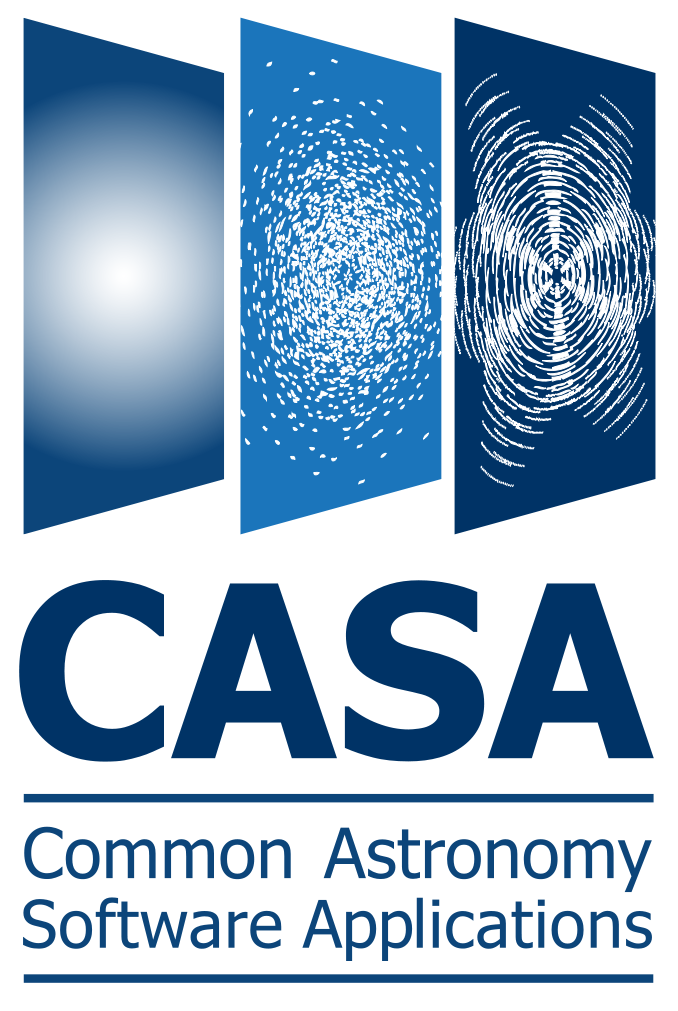
The Common Astronomy Software Applications (CASA) and Pipeline software development teams, in conjunction with ALMA scientists, have done a tremendous job putting together CASA 5.4.0 for ALMA Cycle 6 operations. In ALMA Cycle 6, we are pleased to announce the first pipeline use of parallel tclean in CASA to achieve substantial performance improvement for imaging. The road to scalable parallel interferometric imaging has been a long one with many hours spent carefully comparing against legacy serial performance. While several small issues remain to be resolved in the upcoming CASA 5.5 release, we are confident that modes utilized by the ALMA imaging pipeline are mature and suitable for telescope operations.
The Very Large Array (VLA) and VLA Sky Survey (VLASS) pipelines continue to mature with VLASS set to utilize the calibration pipeline in 5.4.0. VLA pipeline will be utilizing CASA 5.4.1 containing several small additions and modifications not needed by ALMA but desired for the broader CASA community and serving as our latest recommended release.
CASA 5.4 has also brought about a profound change to the way we understand and react to real world usage of the software. As described in more detail elsewhere in this newsletter, the new telemetry recording will enable us to see how well (or not!) CASA is working for the user community including the performance, popularity, and reliability of each task. This information recording is completely anonymous, voluntary, and contains no science data.
On other fronts, we are excited about the progress made thus far with our next major revision, CASA 6, planned for initial release next May. As we explained in the previous edition of the CASA Newsletter, CASA 6 contains many long awaited and requested improvements including the migration to python 3 and the ability to import CASA in to a standard python environment.
Finally, the long awaited initial release of the Cube Analysis and Rendering Tool for Astronomy (CARTA) is nearly upon us. The CASA Viewer has not been maintained for some time now in anticipation of replacement by a brand new application. Software development teams from Academia Sinica Institute of Astronomy and Astrophysics in Taiwan, the Institute for Data Intensive Astronomy in South Africa, and NRAO have collaborated to make great strides in developing an efficient and high performance CARTA release. We anticipate robust and responsive performance up to terabyte-scale image cube sizes with a flexible and customizable interface. Further announcements on the availability of the initial CARTA release will be made soon.
CASA 5.4 Release

Plotting caltables in plotms
[click to enlarge]
Fall releases are CASA pipeline releases. Hence, our brand new CASA 5.4.0 release contains the official ALMA Cycle 6 data reduction pipeline. A new VLA pipeline is packaged with the subsequent CASA 5.4.1 release, which will appear mid October.
For more information on the pipelines, please see the ALMA Pipeline information page and/or the VLA Pipeline information page.
In CASA itself, we made significant improvements, including the official publication of the new statwt task that has more flexible options for data selection, rms computation, and works with channelized weights.
A big leap forward is the support of all typical calibration tables for plotting in plotms (examples are shown in the Figure). This makes plotcal obsolete and we will remove it from CASA in the future. We thus encourage all users to switch to plotms for calibration table plotting.
The tclean task can now image multiple MeasurementSets with ephemeris data in a single execution. We also added a 'mosweight' parameter to tclean to restrict or enable weighting calculations for individual pointings. We also continued to improve automasking developments, as presented the Automated masking article.
An important change for VLA users will be the transition from importevla to importasdm, and we provide instructions on the details in the Task Deprecations article.
As always, we also fixed a number of bugs and worked to improve the overall performance of CASA. Complete lists of new features are provided in the CASA 5.4.0 and 5.4.1 Release Notes.
CASA User Survey Results
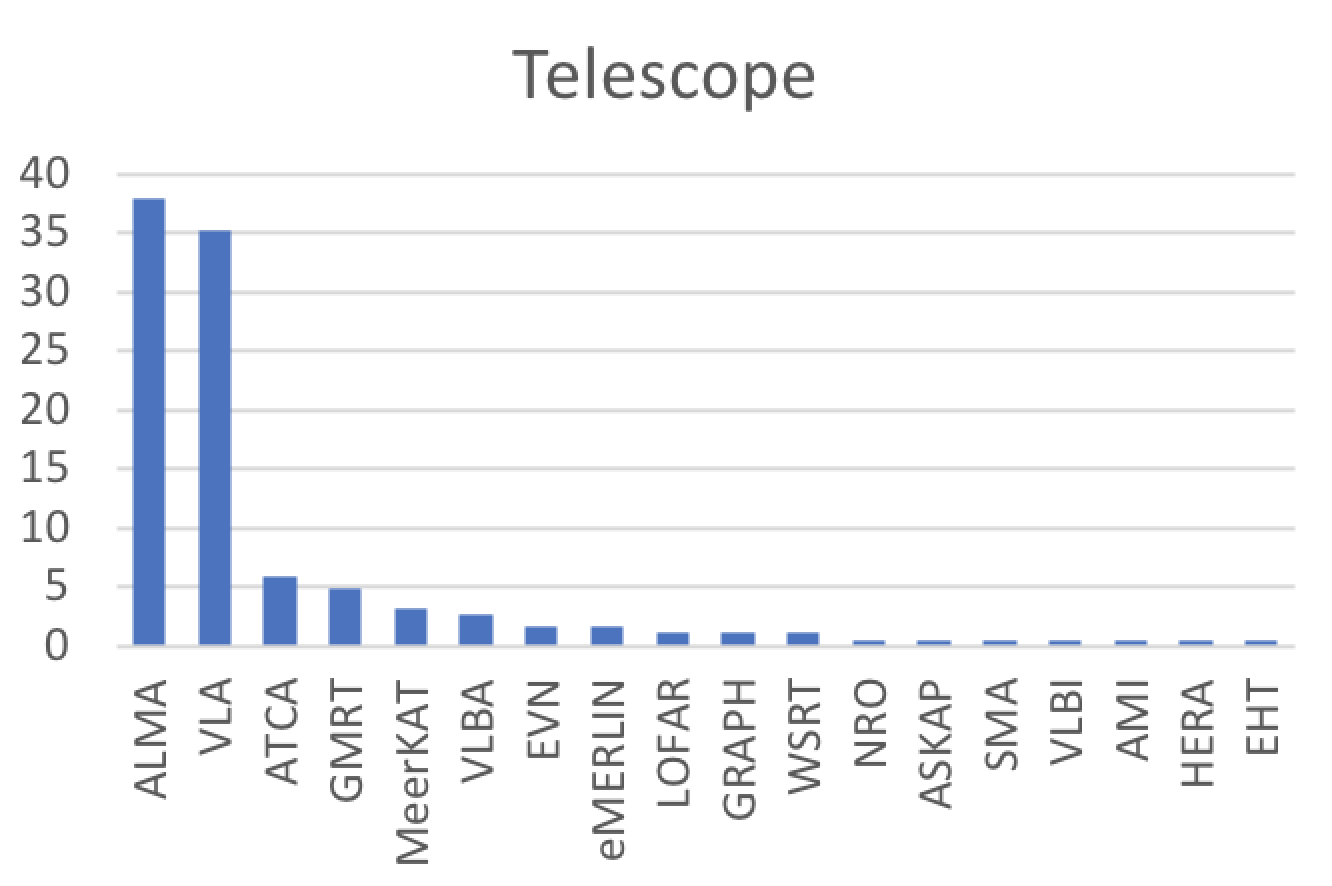
Fig. 1: Telescopes for which CASA is used as processing software, in % of total.
[click to enlarge]
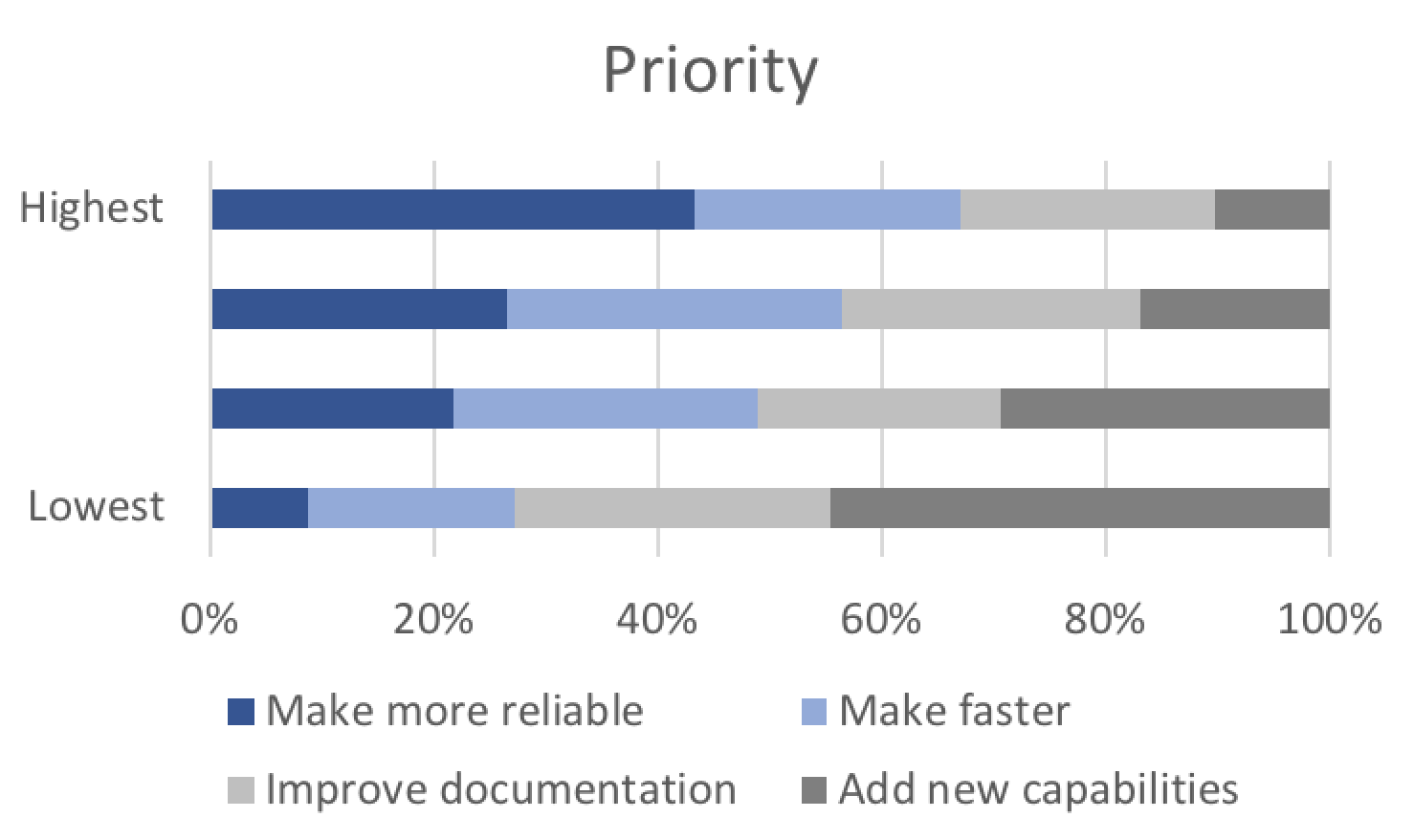
Fig. 2: User priorities according to the CASA Survey, plotted against % of user responses. Shown are 'reliability' (dark blue), 'speed' (light blue), 'documentation' (light grey) and 'capabilities' (dark grey).
[click to enlarge]
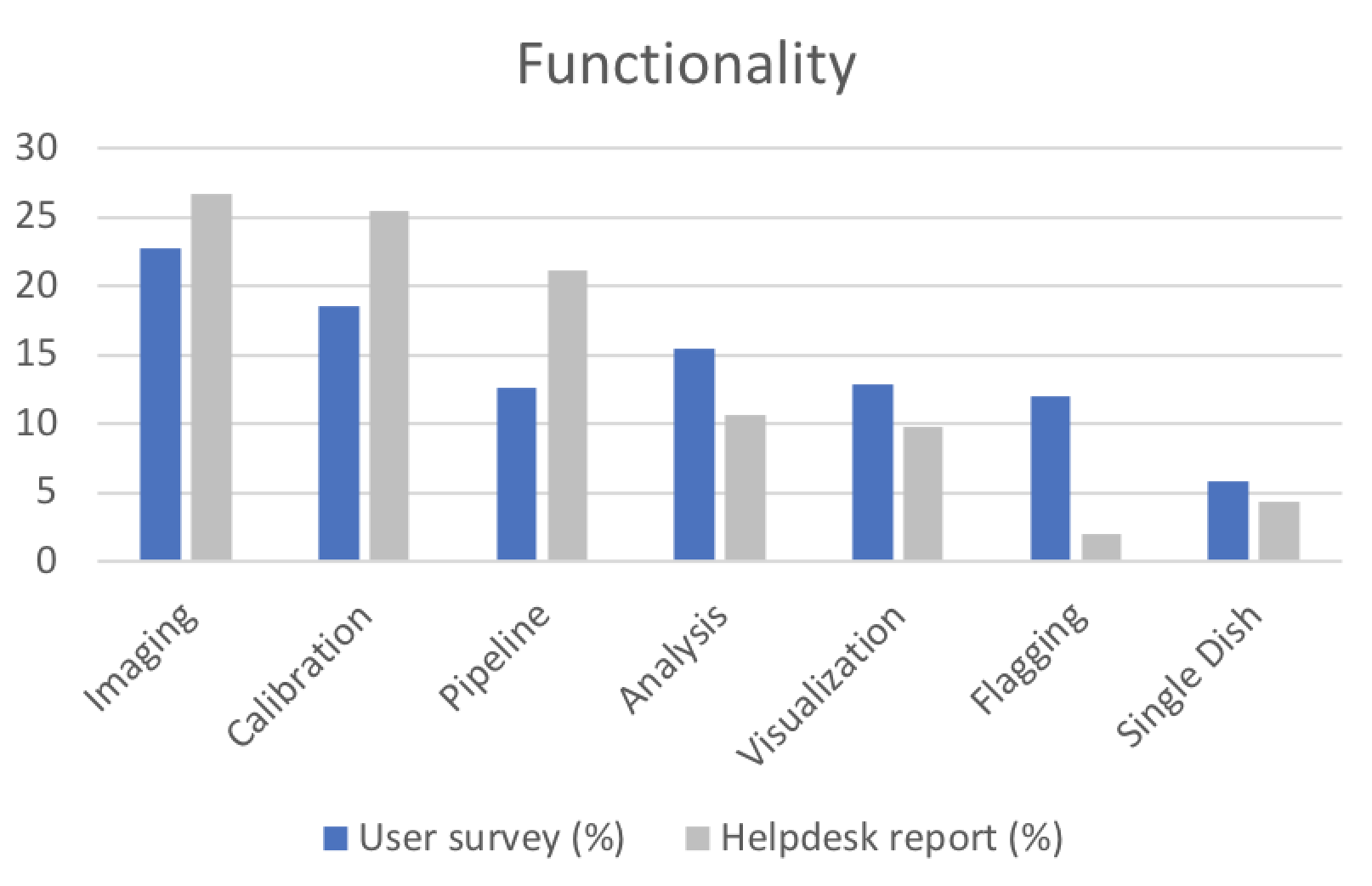
Fig. 3: Functionalities in CASA ranked by importance as indicated in the User Survey (blue) and by issues reported in the NRAO and ALMA Helpdesks (grey), both in % of total.
[click to enlarge]
Last CASA Newsletter, we announced a short CASA User Survey to obtain feedback from you, as user community, on your use of CASA. We thank you very much for the many responses! As of 1 October, we received 101 completed forms. This feedback is extremely valuable to the CASA team, and it will be taken to heart when planning future CASA releases.
The Survey responses show a balanced geographical distribution (40% North America, 33% Europe, 11% Asia, 6% Latin America, 3% Africa, 2% Oceania, 5% unknown). While ALMA and VLA are the primary telescopes that rely on CASA, our community uses CASA as data processing software for a large number of telescopes, including several Very Long Baseline Interferometry (VLBI) facilities (Fig 1). These results are a testament to our world-wide user base, something the CASA team acknowledges.
When it comes to CASA priorities, the request from the user community is to put an emphasis on making CASA more reliable, so that the software that we deliver works as expected (Fig.2). Making CASA faster and improving the documentation are also considered important. Adding new capabilities to CASA is the lowest overall priority for users, although we realize that this priority is important to a small group of users that cannot be ignored.
In parallel to this User Survey, we have also analyzed statistics of all CASA-labeled tickets from the NRAO and ALMA Helpdesks over the course of the last 10 months. Of these CASA-related tickets, 46% came through the NRAO Helpdesk (mostly VLA-related) and 54% through the three regional ALMA Helpdesks (East Asia, Europe, and North America). These Helpdesk statistics identify areas where users experience problems. When ranking the importance of different functionalities in CASA from the User Survey, these broadly agree with the areas of CASA where users report issues through the Helpdesk (Fig. 3).
Finally, the User Survey allowed CASA to obtain a much better idea of the different CASA versions and operation systems that are in use, which will guide the CASA team in planning our release and support efforts.
The CASA team is already in the process of prioritizing our efforts for CASA 5.5 in accordance with recommendations provided by this Survey. Most importantly, we are gradually improving on reliability with a new approach to testing, validating and documenting CASA developments. At the same time, we are aiming to be realistic in terms of implementing new features in CASA 5.5.
A more elaborate analysis of both the Survey results and Helpdesk statistics will be presented in an upcoming CASA memo. For the time being, the CASA User Survey will remain open for those who want to provide feedback.
Thanks again for helping us improve CASA!
Auto-multithresh: An Automated Masking Algorithm for tclean
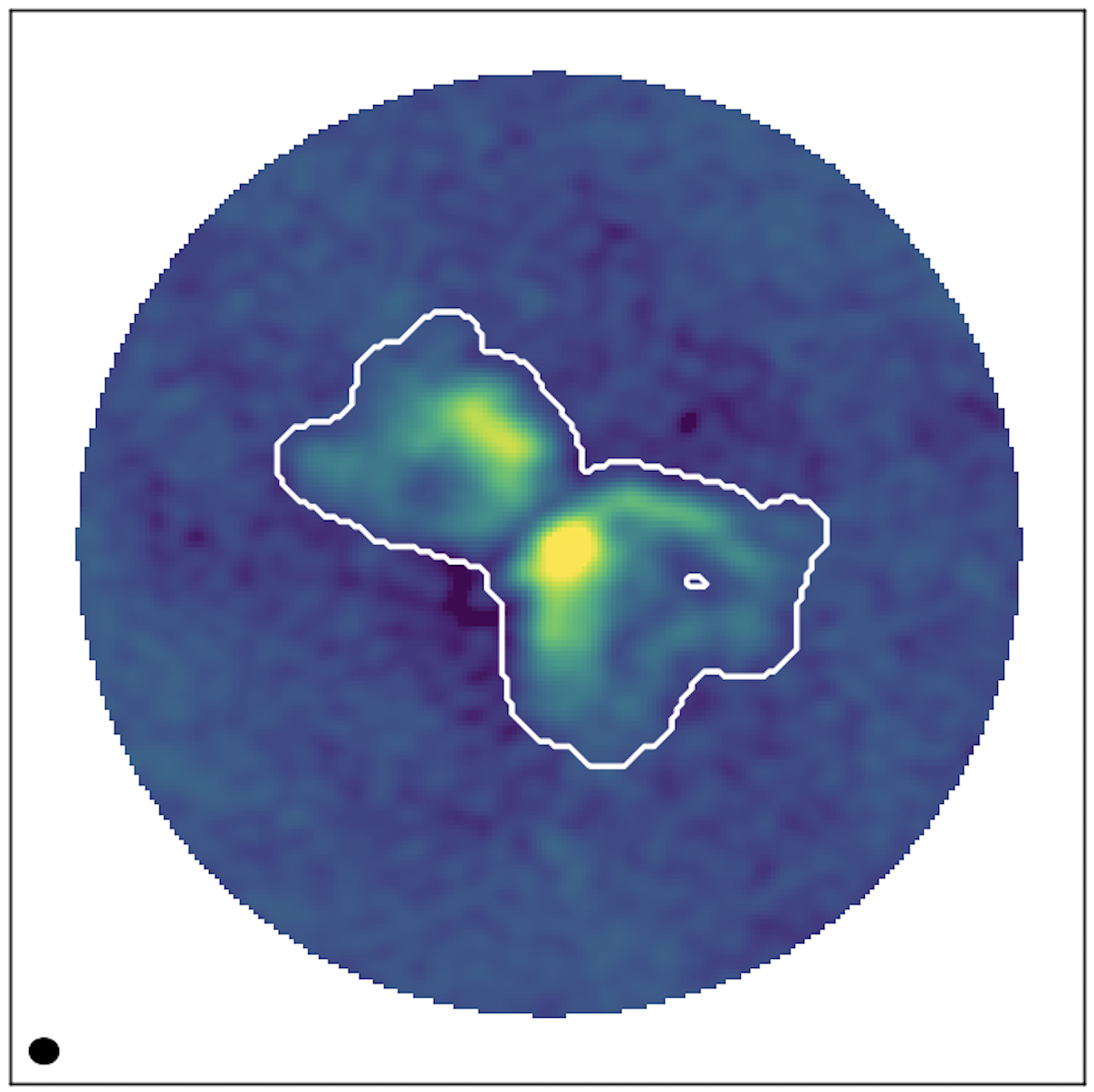
Fig. 1: Channel map of a protostellar outflow imaged by the ALMA 12m array. The white contour shows the mask produced by auto-multithresh.
[click to enlarge]
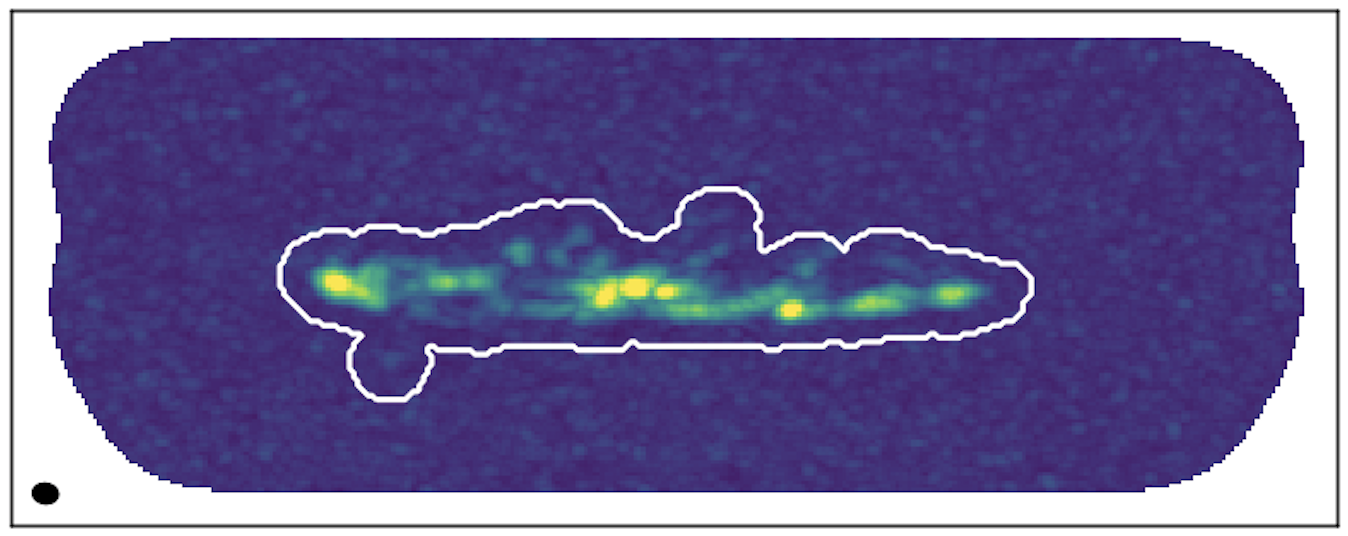
Fig. 2: Integrated peak intensity image of molecular emission from the disk of an edge-on spiral galaxy imaged by the ALMA 7m array. The white contour shows the combined mask for all channels.
[click to enlarge]
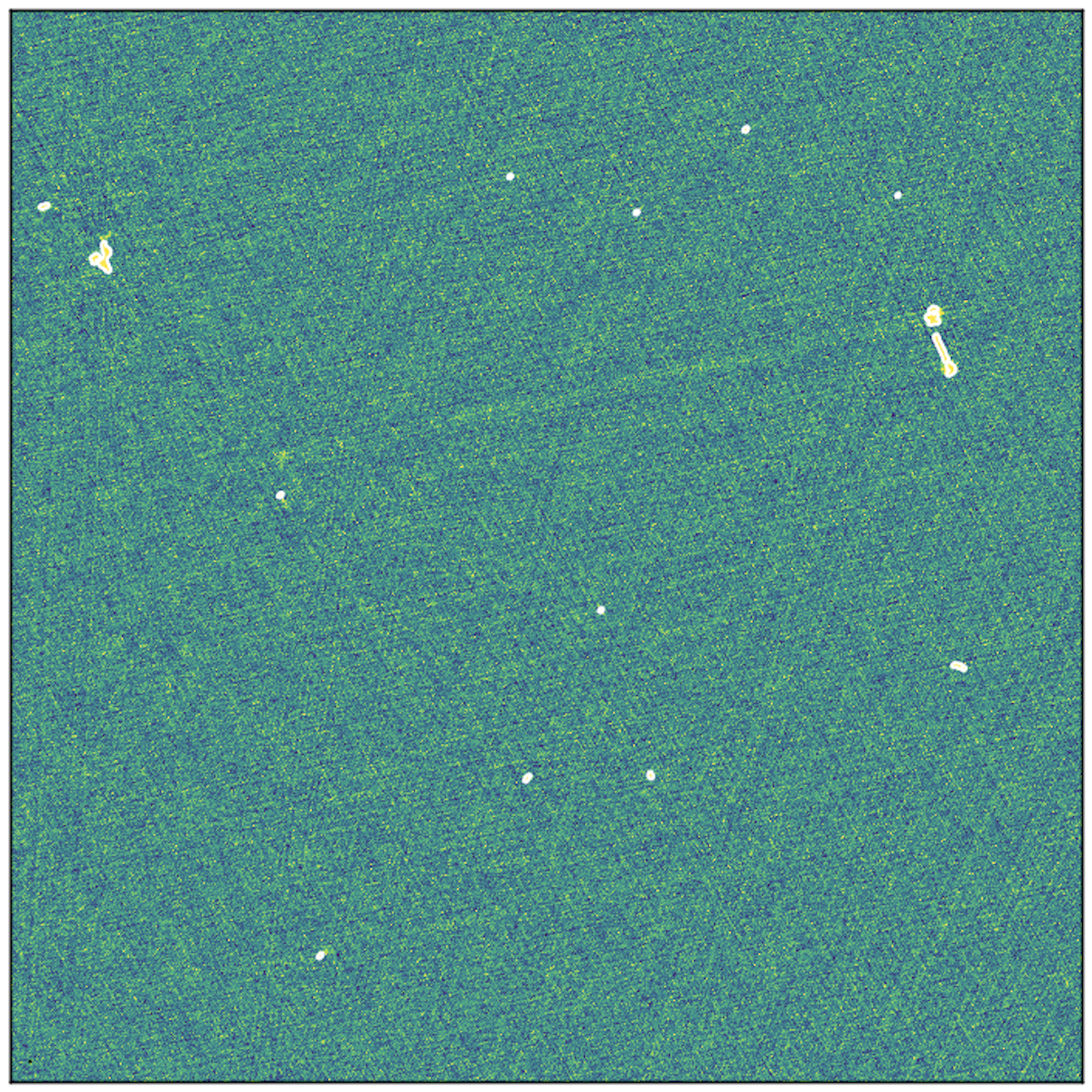
Fig. 3: 21cm continuum image taken with the VLA in A-configuration. The white contour shows the mask.
[click to enlarge]
Manually masking images while cleaning has been a rite of passage for many radio astronomers. It’s a great task for a rainy Friday afternoon for small data sets, but quickly becomes overwhelming for the large data volumes produced by ALMA and the JVLA. More importantly, it limits the quality of the images that can be produced by automated imaging pipelines.
Prior to Cycle 5, the ALMA imaging pipeline used a large primary beam mask and cleaned shallowly to avoid creating poor models for sources. This approach was inadequate for the many ALMA projects that image complex emission like outflows from young massive stars or molecular emission from galaxies. For the ALMA Cycle 5 imaging pipeline, A. Kepley led a major software development effort to automate masking with tclean so that the pipeline could clean images more deeply. The resulting algorithm we refer to as ‘auto-multithresh’, which is short for automated masking using multiple thresholds. It can be enabled within tclean by setting usemask=‘auto-multithresh’.
The `auto-multithresh’ algorithm works by evaluating noise and sidelobe thresholds for a given residual image to set an initial mask and then cascades that mask down to lower signal to noise. The mask is evaluated at the beginning of every minor cycle, so that it updates as the residuals change. Finally, all parameters are specified relative to the fundamental properties of the image (noise, beam size, sidelobe level, etc), so that they do not have to be adjusted for every image. A paper is in preparation with a more detailed explanation of the algorithm.
The accompanying images show some examples of the `auto-multithresh’ algorithm in action on ALMA and VLA data. The algorithm successfully captures emission from point and extended sources in images with varying noise and sidelobe levels. Although it was originally developed exclusively using ALMA data, the algorithm also works well for a wide variety of data ranging from VLA 21cm continuum data to the Australia Telescope Compact Array (ATCA) spectral line observations with some adjustment of the control parameters. A CASA Guide on automasking has been developed for users who wish to explore adjusting these parameters.
The initial `auto-multithresh’ algorithm was developed using a Python prototype, which was then implemented in C++ within CASA by T. Tsutsumi. An early version of the algorithm was available in CASA 5.0. The first full iteration of the algorithm was available in CASA 5.1.0 and was used in production for the ALMA Cycle 5 pipeline. Major speed improvements, especially for cubes with large numbers of channels, were implemented in CASA 5.3. The development of this algorithm will be completed in CASA 5.5 with the addition of a revised noise calculation that improves masks for cases with significant absorption and/or emission covering a large fraction of the field of view.
Telemetry Data Collection
The CASA project has been working on improving the robustness of the software over the past several years. CrashReporter was introduced in CASA 5.0.0 to let the development team diagnose crashes that occur in the field. To complement the crash analysis, CASA 5.4 introduces telemetry data collection. The goal of the data collection is to collect task-level data to better understand CASA usage patterns and to elicit relative quality metrics to further improve CASA. We do not collect personally identifiable information or observing data. Telemetry data is sent to NRAO only and used in conjunction with Crash Reports to provide data of the robustness of the CASA software. The telemetry collection process is designed to be nonintrusive to the end user.
Starting with CASA 5.4.1, telemetry is on by default and each CASA run will cache telemetry files under ~/.casa directory. This data is then submitted to NRAO on a predefined time interval. The default is 1 week. You can redefine the data submission interval and other parameters to your liking via ~/.casarc configuration.
You will see a notification at the start up time when the telemetry data collection is enabled. We recognize that not every project is willing or able to participate to the data collection, therefore we have also made disabling telemetry easy. You can do so either via environment variable or by setting the option in the ~/.casarc file. You can read more about the configuration options in CASA Docs.
We will be refining the telemetry data collection based on the results of this initial effort and hope to be able to share the results with you in the future.
The Sky is the Limit: CASA Images Terahertz Water Jets
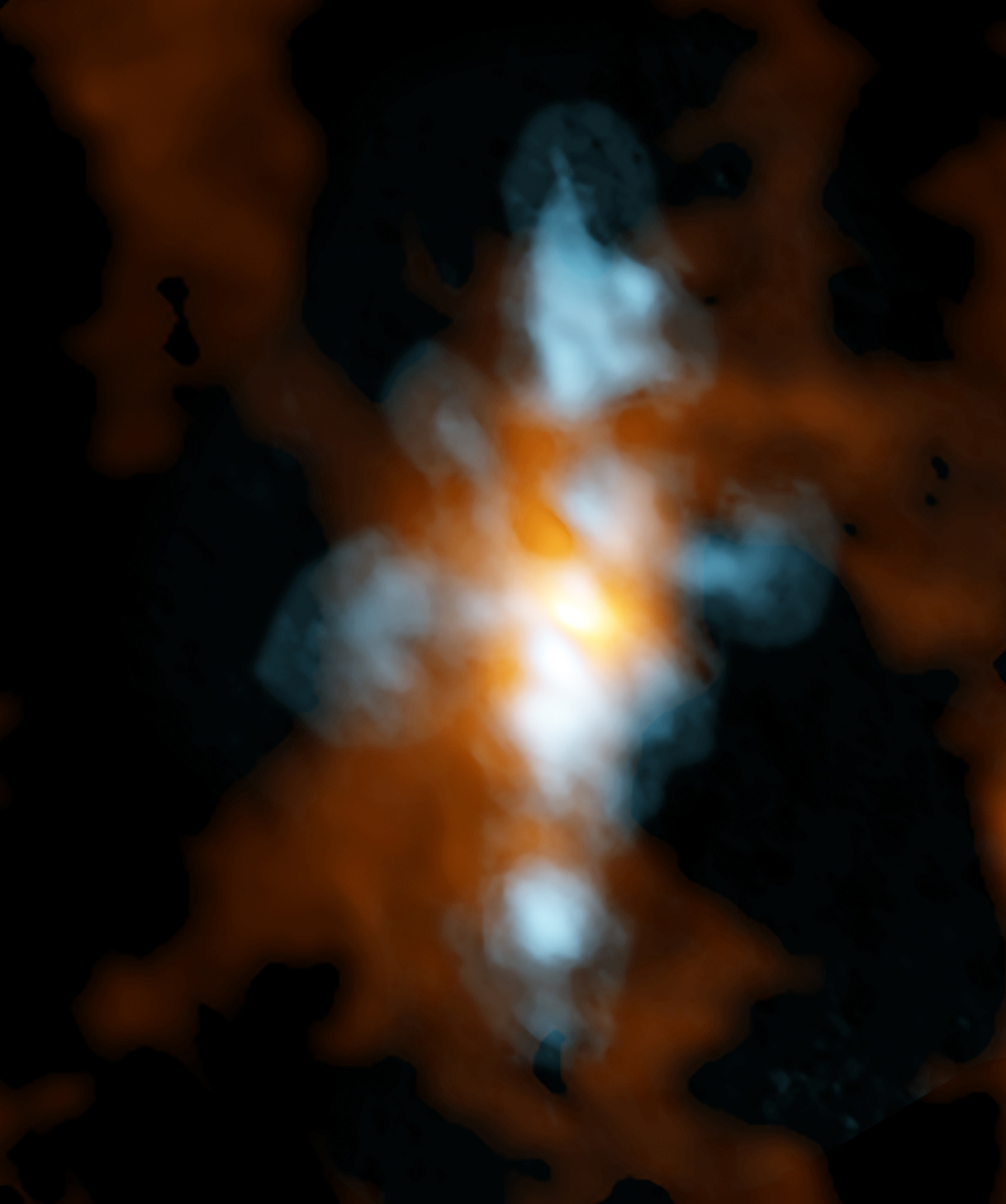
ALMA (ESO/NAOJ/NRAO): NRAO/AUI/NSF, B. Saxton
ALMA Band 10 image of NGC 6334I. The blue component is heavy water (HDO) streaming away from a protostar or cluster of protostars. The orange component is continuum emission, which is extraordinarily rich in complex molecules.
[click to enlarge]
One of the core aspects of CASA development is support of the ALMA and VLA pipelines. Continuous development of both the pipelines and underlying CASA software is mostly driven by increasingly challenging and exciting science.
In a recent milestone, the ALMA pipeline produced the first scientific images and spectra from ground-based interferometric observations in the terahertz regime. Using the highest-frequency Band 10 capabilities of ALMA, a team of scientists led by Brett McGuire (NRAO) has uncovered jets of warm water vapor streaming away from a newly forming protostar, or cluster of protostars.
The image shows the submillimeter-wavelength light naturally emitted by heavy water (HDO) in the starforming region NGC 6334I. According to McGuire: “…the heavy-water jets seen by ALMA are likely recent features just beginning to move out into the surrounding nebula, which is itself rich in complex molecules.”
An equally impressive spectrum, obtained by use of the ALMA pipeline and CASA software, revealed a frequency region that is extraordinarily rich in complex molecules, including glycoaldehyde, the simplest sugar-related molecule. When compared to the Herschel Space Observatory, ALMA detected more than ten times as many spectral lines in this region.
As noted by Crystal Brogan, co-author of the study and ALMA CASA subsystem scientist: “challenging ALMA data, such as these first-of-their-kind Band 10 observations, are invaluable in identifying where the CASA software and ALMA pipeline need further development.” This synergy between CASA, the pipeline, and the scientific community helps the CASA and pipeline teams to continue pushing the limits of radio astronomy.
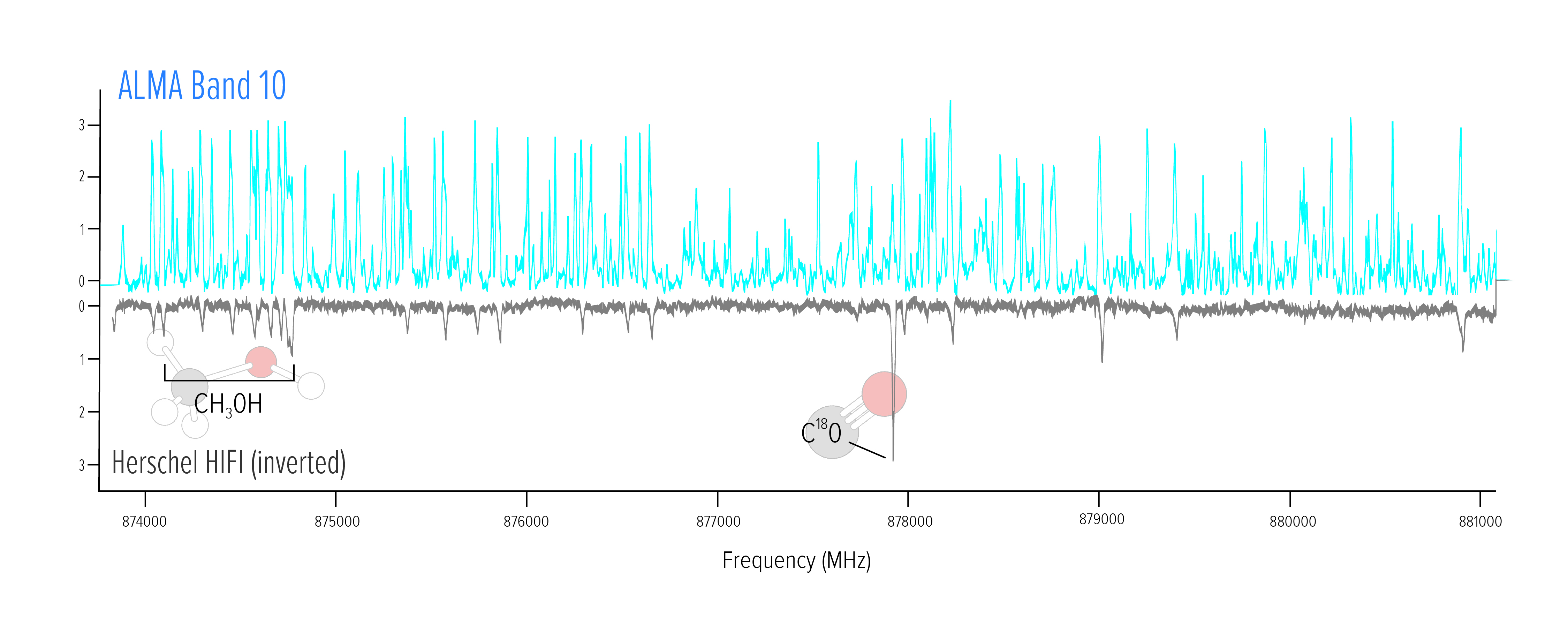
NRAO/AUI/NSF, B. McGuire et al.
Blue spectral lines ALMA detected in NGC 6334I. Black emission lines detected by Herschel Space Observatory (inverted for comparison). Two molecular lines are labeled for reference.
[click to enlarge]
ALMA media release: www.almaobservatory.org/en/press-release/first-science-with-almas-highest-frequency-capabilities/
Publication: B. McGuire, C. Brogan, T. Hunter, et al. “First Results of an ALMA Band 10 Spectral Line Survey of NGC 6334I: Detections of Glycolaldehyde (HC(O)CH2OH) and a New Compact Bipolar Outflow in HDO and CS”, The Astrophysical Journal, 863, 35 (2018)
CASA Task Deprecations
The CASA team is dedicated to delivering software that is being actively maintained and optimized for users and pipeline. After consulting the CASA stakeholders, a number of CASA tasks that were no longer actively maintained by the CASA team were deprecated and are no longer included in CASA 5.4. Where needed, the functionality of these deprecated tasks is now captured by other tasks.
The list of deprecated tasks includes: autoclean, boxit, clearplot, csvclean, importevla, mosaic, plotuv & plotxy (capabilities transferred to plotms), ssoflux, widefield, and older versions of some tasks (oldhanningsmooth, oldpartition, oldplotants and visstatold). Please update your scripts if you use any of these tasks. More information on existing tasks can be found in CASA Docs.
For users of the Very Large Array (VLA), the most noticeable difference may be the deprecation of the task importevla. Its functionality is replaced by importasdm, which is also being used by the VLA pipeline. However, several additional steps are required to duplicate the behavior of importevla when using importasdm. This involves a difference in default parameters and the fact that some of the on-the-go flagging cannot be performed by importasdm.
To mimic the behaviour of importevla, change the following parameters in importasdm from their default settings:
- ocorr_mode = 'co' to import cross-correlations only (discarding auto-correlations)
- with_pointing_correction = True to add pointing corrections
- process_flags = True (default) to read in the online flag, then applyflags = True to apply the online flags and/or savecmd = True to save flags to an ascii table.
- For ephemeris objects: convert_ephem2geo = False
While online flags can thus be created by leaving the parameter process_flags = True by default, additional flagging steps need to be performed after importasdm to clip zero values and flag shadowed antennas. This can be done with the task flagdata, using mode=`shadow’ and mode=`clip’ / clipzeros = True.
More information can be found on the importasdm task-pages in CASA Docs.
Career Opportunities
The CASA team is growing! We are currently looking for qualified Software Engineers and a Software Architect to join the CASA development team at NRAO. These positions are located at either the VLA Array Operations Center in Socorro, NM USA, or NRAO headquarters (ALMA NAASC) in Charlottesville, VA USA.
Please refer to the following job announcements:
In the very near future we hope to post an additional opening for a Scientific Developer to join the imaging software group within the CASA development team. Stay tuned for a follow up announcement on that position.
CASA Calendar
Dates |
Event |
Location |
|---|---|---|
25-26 Oct 2018 |
Socorro, NM, USA |
|
16-23 Nov 2018 |
College Park, MD, USA |
|
1 Feb 2019 |
n/a |
|
Feb 2019 |
CASA 5.5 release |
n/a |

